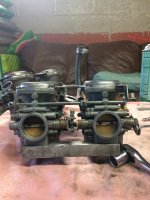For me, the easiest and most fool-proof way to determine when a cylinder is at TDC on it's compression stroke is to turn the motor over by hand and watch the valve action on the cylinder in question. Watch for the intake valve to open and close. Keep turning and watch for the exhaust valve to open and close. Keep turning until the intake valve opens and closes again. Now start watching the timing marks as you will be approaching TDC on the compression stroke for that cylinder. If the exhaust valve starts opening again, you've gone too far, past the TDC point. It's best not to go backwards but rather to continue on in the direction of rotation for the motor (CCW when viewed from the left side) until after the intake opens and closes again, and is approaching TDC on the compression stroke again.
I'm not all that familiar with rephases but I'm going to assume the original rotor mark and "T" (TDC) mark on the stator will still work for one of the cylinders. For the other, the one that's been rephased, you'll probably need to make new marks. To accurately locate TDC on that changed cylinder, you would need a degree wheel and/or piston stop, but you can roughly locate it using a drinking straw stuck in the spark plug hole, and that may be close enough for doing a valve adjustment.








